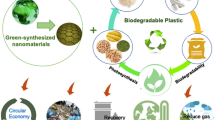Abstract
The goal of this work was to create a new generation of greener fabrics made of natural materials. For that, resveratrol (Res), obtained from Polygonum cuspidatum extract and known to have antibacterial, antifungal, and anti-inflammatory activity, was applied by an exhaustion method to cotton, bamboo, and silk knit fabrics. The fabrics adsorption behavior was tested and the amount of Res adsorbed was determined by its decrease on the immersion solutions with time and measured by spectrophotometry at 350 nm. The maximum adsorption capacity was observed for silk and it was independent of pH conditions used (50.5 % at pH=7 and 58.3 % at pH=5 of the initial Res concentration). At acidic pH conditions, cotton adsorbed 51.2 % of Res and Bamboo adsorbed only 28.1 % in 15 min. However, neither cotton nor bamboo adsorbed Res at pH=7. The release behavior was also analyzed and the highest Res release was observed for cotton in alkaline sweat and urine mimic solutions. The lowest release was achieved by cotton in water (1.0 ng/ml). Moreover, no relation was found between the amounts of Res adsorbed or released and cell viability. In conclusion, this work shows that it is possible to obtain cotton, bamboo, and silk functionalized with resveratrol. The incorporating process here described is simple and silk-Res can be presented as a good combination.
Similar content being viewed by others
References
T. B. Volkmar in “Biofunctional Textiles and the Skin. Curr Probl Dermatol”, 1st ed. (U. C. Hipler, P. Elsner, G. Burg, and P. H. Itin), Vol. 33, pp.51–66, Kanger Publishers, 2006.
K. Takai, T. Ohtsuka, Y. Senda, M. Nakao, K. Yamamoto, J. Matsuoka, and Y. Hirai, Microbio. Immuno., 46, 75 (2002).
P. A. Deshpande, M. B. Rao, and C. L. Rao, J. Appl. Polym. Sci., 76, 83 (2000).
Y. Takagai, T. Kubota, H. Kobayashi, T. Tashiro, A. Takahashi, and S. Igarashi, Anal. Sci., 21, 183 (2005).
R. Vieira, Master Dissertation, Universidade do Minho, Guimarães, 2006.
G. J. S. Alves, N. Raphaelli, and R. Fangueiro, in XXII Congresso Nacional de Técnicos Têxteis — VIII Fenatêxtil, Recife, Brazil, 2006.
S. Hofmann, C. T. Wong Po Foo, F. Rossetti, M. Textor, G. Vunjak-Novakovic, D. L. Kaplan, H. P. Merkle, and L. Meinel, J. Control. Release, 111, 219 (2006).
G. H. Altman, F. Diaz, C. Jakuba, T. Calabro, R. L. Horan, J. Chen, H. Lu, J. Richmond, and D. L. Kaplan, Biomaterials, 24, 401 (2003).
M. S. Baliga and S. K. Katiyar, Photochem. Photobiol. Sci., 5, 243 (2006).
B. Yan, D. Xing, Y. Ding, J. Tao, and L. J. Du, J. Pharm. Biomed. Anal., 37, 297 (2005).
C. F. Hung, Y. K. Lin, Z. R. Huang, and J. Y. Fang, Biol. Pharm. Bull., 31, 955 (2008).
M.-T. Huang, G. Ghai, and C.-T. Ho, Comprehensive Reviews in Food Science and Food Safety, 3, 127 (2004).
M. H. Aziz, R. Kumar, and N. Ahmad, Int. J. Oncol., 23, 17 (2003).
E. Jr. Middleton, C. Kandaswami, and T. C. Theoharides, Pharmacol. Rev., 52, 673 (2000).
M. Araújo and E. M. Castro de Melo in “Manual de Engenharia Têxtil”, 1st ed., vol. I, Fundação Calouste Gulbenkian, 1986.
ISC 114948-1, “International Standard — Urine — Absorbing Aids — Part 1: Whole-production Testing”, 1996.
ISO105 E04, “Textiles — Tests for Colour Fastness — Part E04: Colour Fastness to Perspiration”, 1997.
ISO 9073-8, “Textiles — Test Methods for Nonwovens — Part 8: Determination of Liquid Strike-through Time (simulated urine)”, 2000.
I. D. Ratter and M. M. Breuer in “The Physical Chemistry of Dye Adsorption”, 1st ed., Academic Press Inc (London) LDT, 1974.
G. Malich, B. Markovic, and C. Winder, Toxicology, 124, 179 (1997).
M. H. Aziz, S. Reagan-Shaw, J. Wu, B. J. Longley, and N. Ahmad, FASEB J., 19, 1193 (2005).
J. A. Gescher and W. P. Steward, Cancer Epidem. Biomar., 12, 953 (2003).
Author information
Authors and Affiliations
Corresponding author
Rights and permissions
About this article
Cite this article
Pinho, E., Henriques, M., Oliveira, R. et al. Development of biofunctional textiles by the application of resveratrol to cotton, bamboo, and silk. Fibers Polym 11, 271–276 (2010). https://doi.org/10.1007/s12221-010-0271-x
Received:
Revised:
Accepted:
Published:
Issue Date:
DOI: https://doi.org/10.1007/s12221-010-0271-x




